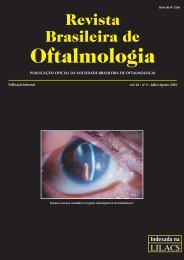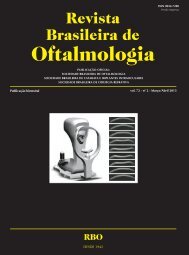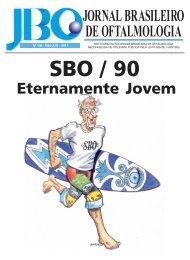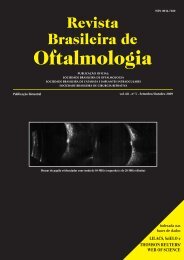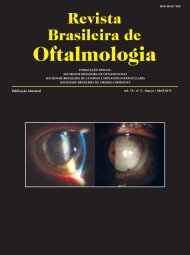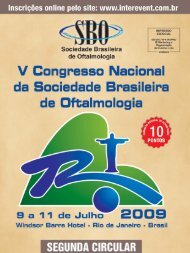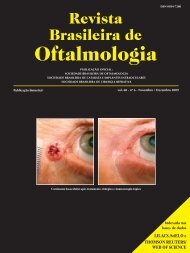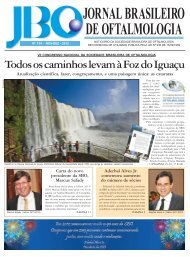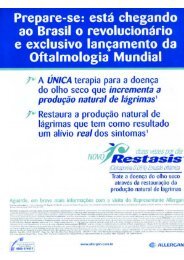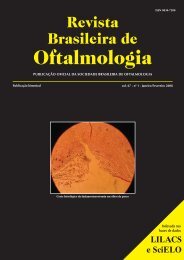Jan-Fev - Sociedade Brasileira de Oftalmologia
Jan-Fev - Sociedade Brasileira de Oftalmologia
Jan-Fev - Sociedade Brasileira de Oftalmologia
- No tags were found...
You also want an ePaper? Increase the reach of your titles
YUMPU automatically turns print PDFs into web optimized ePapers that Google loves.
8 Nakano CT, Hida WT, Kara-Jose Junior N, Motta AFP, Reis A, Pamplona M, Fujita R, Yamane I, Holzchuh R, Avakian A<br />
INTRODUCTION<br />
Since the 1970’s, the importance of preserving<br />
the corneal endothelium has been established as<br />
a factor in the recovery from post-operatory<br />
e<strong>de</strong>ma (1-3) . Durovic et al. has suggested that corneal<br />
e<strong>de</strong>ma is one of the main causes of low visual acuity in<br />
the immediate postoperative period after intraocular<br />
surger (4) .<br />
As a rule, candidates to cataracts surgery aim for<br />
early visual recovery after the procedure, so that they<br />
can resume their routine activities (5,6) . Surgery performed<br />
by phacoemulsification with small incision induces little<br />
corneal e<strong>de</strong>ma, and provi<strong>de</strong>s early visual recovery (7,9) .<br />
The main causes of corneal endothelium e<strong>de</strong>ma after<br />
phacoemulsification surgery is believed to be: the thermal<br />
energy released by ultrasonic frequency vibration of the<br />
tip and turbulent flow of fluid and particles within the<br />
anterior chamber (4,10,11) .<br />
In or<strong>de</strong>r to reduce endothelial injury, the following<br />
alternatives have been <strong>de</strong>veloped: viscoelastic<br />
substances (12-15) ; special surgical techniques such as, for<br />
example, nuclear prefracture; and new modalities of tip<br />
vibration at ultrasonic frequency, such as the White-star ® ,<br />
Neosonix ® , dynamic rising time and torsional systems<br />
(1,2,5,6,16-23)<br />
.<br />
By the year 2000, an alternative technology was<br />
proposed for cataracts surgery (5,16,17) . This modality, named<br />
Aqualase ® , consists in the liquefaction of the lens core by<br />
jets of balanced saline solution (BSS) without tip<br />
vibration. Therefore, the thermal energy release<br />
component is eliminated as a causal factor of<br />
postoperative corneal e<strong>de</strong>ma. This method is assumed to<br />
provi<strong>de</strong> for safe and effective emulsification of lenses<br />
with cataracts up to gra<strong>de</strong> 2, based on the brunescence<br />
criterion of the Lens Opacities Classification System,<br />
LOCS II (1,5,16,17) . Some findings suggest that liquefaction<br />
could not be a good option for har<strong>de</strong>r cataract nuclei (16,17) .<br />
Several studies have been performed comparing<br />
different surgical techniques and mo<strong>de</strong>s of modulating<br />
the physical parameters of the phacoemulsifier, with the<br />
objective of <strong>de</strong>monstrating the benefits of reducing<br />
conventional phacoemulsification-induced corneal<br />
e<strong>de</strong>ma, but very few studies have compared the technique<br />
of conventional phacoemulsification with liquefaction<br />
of the lens core by Aqualase ® (2,3,7,8,11,15-19) .<br />
The purpose of this study is to assess central<br />
corneal e<strong>de</strong>ma and visual recovery after cataract surgery<br />
performed according to two approaches: conventional<br />
phacoemulsification and liquefaction by Aqualase ® .<br />
METHODS<br />
This randomized clinical trial was conducted<br />
according to established ethical standards for clinical<br />
research and the Institutional Review Board of<br />
University of São Paulo Medical School General Hospital<br />
(HC-FMUSP) has approved the protocol. In or<strong>de</strong>r to<br />
maintain the study blinding, physicians conducting<br />
postoperative evaluation did not have access to the<br />
randomization co<strong>de</strong>s or the patients’ medical records.<br />
Twenty patients, with mean age of 65.13 ± 6.34<br />
years (ranging from 58 to 72) un<strong>de</strong>rwent cataract surgery.<br />
The inclusion criteria for the study were bilateral<br />
cataract, up to gra<strong>de</strong> 2 of nuclear opalescence (Lens<br />
Opacities Classification System, LOCS II) in both eyes<br />
(1)<br />
, with normal age-matched endothelial count (more than<br />
2000 cells/mm 2 ), and no other ocular surgery or illness.<br />
Preoperative ocular examinations inclu<strong>de</strong>d<br />
Snellen visual acuity, <strong>de</strong>tailed biomicroscopic<br />
examination, Goldmann tonometry, and axial length<br />
measurement (AL) with ultrasonic technology. Written<br />
informed consent was obtained from each patient.<br />
Both eyes of each patient was inclu<strong>de</strong>d in the study.<br />
For the first surgery, the eyes were randomized to<br />
Aqualase ® or conventional phacoemulsification. The<br />
fellow eye was submitted to the surgery 30 days after the<br />
first, with the opposite technique.<br />
All surgeries were performed between March<br />
2005 and July 2006 by the same surgeon (C.T.N.), with<br />
the same technique and preoperative peribulbar<br />
anesthesia. Cyclopentolate 1% and phenylephrine 2.5%<br />
eye drops were used three times for obtaining mydriasis,<br />
1 hour before the surgery. A three step clear corneal<br />
tunnel self-sealing incision was ma<strong>de</strong> with a 2.75 mm<br />
disposable metal bla<strong>de</strong> on the steepest axis and a si<strong>de</strong><br />
port incision. After inject dispersive and cohesive<br />
ophthalmic viscosurgical <strong>de</strong>vices (Celoftal and Provisc,<br />
Alcon Laboratories, Fort Worth, Texas, USA) into the<br />
anterior chamber using the soft shell technique (20) , uttrata<br />
forceps was used to grasp the capsule and perform the<br />
capsulorhexis (2) . Karate pre chop technique with<br />
Akahoshi’s pre chopper to make the initial fracture and<br />
endocapsular phacoemulsification was performed in all<br />
eyes by using Infiniti ® Vision System Phacoemulsification<br />
machine (Alcon Laboratories, Fort Worth, Texas, USA)<br />
using both technologies, Aqualase ®<br />
and conventional<br />
ultrasonic unit. Corneal incision was enlarged to 3.00<br />
mm, a foldable hydrophobic acrylic SA30AC (Alcon<br />
Laboratories, Fort Worth, Texas, USA) intraocular lens<br />
was implanted in the capsular bag and all the viscoelastic<br />
Rev Bras Oftalmol. 2009; 68 (1): 7-12



